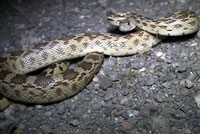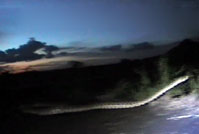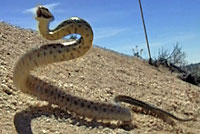Gophersnakes found in California


Not Dangerous (Non-poisonous) Gophersnakes do not have venom that is dangerous to most humans. |
|||
| Gophersnakes are one of the most commonly seen snakes in California. Primarily active during the day, they are also active after sundown on hot days. They are often observed crawling across trails and roads, especially in the morning and evenings when daytime temperatures are high. They are frequently seen around human dwellings, including suburban backyards, attracted to the rodents which thrive in such areas. Unfortunately, this harmless and beneficial species is very often killed out of fear that it is dangerous or that it is a rattlesnake. Take a look at some of the links and information here to help you learn how to know if a snake is a rattlesnake or a Gophersnake. Several similar subspecies occur in California. Look at the map below to determine which one is found in your area. You can also use this key to California Gophersnake subspecies. |
|||
 |
|||
 |
 |
 |
 |
| Sonoran Gophersnake - Pituophis catenifer affinis |
Pacific Gophersnake - Pituophis catenifer catenifer |
San Diego Gophersnake - Pituophis catenifer annectens |
Great Basin Gophersnake - Pituophis catenifer deserticola |
 |
 |
 |
 |
| Santa Cruz Island Gophersnake - Pituophis catenifer pumilus |
|||
 |
 |
 |
 |
| Harmless and beneficial Gophersnakes are often mistaken for the more dangerous rattlesnakes and killed unnecessarily. It is easy to avoid this mistake by learning to tell the difference between the two families of snakes as shown in these signs. Unless you have experience handling venomous snakes, you should never handle a snake unless you are absolutely sure that it is not dangerous. |
|||
| Short Videos | |||
 |
 |
 |
 |
| A Sonoran Gophersnake crawls around in Imperial County. | A Sonoran Gophersnake races across a road just after sunset. | A San Diego Gophersnake flicks its tongue and crawls across a dirt road. | A large Gophersnake crawls off a road in a Mojave desert canyon. |
| The videos below show the feisty side of this species and some of its rattlesnake mimicry. | |||
 |
 |
 |
 |
| A huge Sonoran Gophersnake puts on an impressive defensive display of hissing and blowing. | A distressed Pacific Gophersnake shakes its tail rapidly, which makes a buzzing sound as the tail touches the ground. This behavior might be a mimic of a rattlesnake's rattleing, or it could be a similar behavior that helps to warn off an animal that could be a threat to the Gophersnake. | A Pacific Gophersnake shows its defensive arsenal, which includes coiling, puffing up, and elevating the body, flattening the head into a triangular shape, hissing loudly, shaking the tail, and striking repeatedly. When its tormentor (and photographer) backs off, the snake crawls away, keeping its head and neck defensively arched, ready to quickly coil and strike if needed. | A San Diego Gophersnake is discovered on a dirt road in the morning. It becomes defensive when I follow it, hissing and striking out to warn me to back off. |
 |
|||
| Range Purple: Pituophis catenifer affinis - Sonoran Gophersnake Orange: Pituophis catenifer annectens - San Diego Gophersnake Red: Pituophis catenifer catenifer - Pacific Gophersnake Dark Blue: Pituophis catenifer deserticola - Great Basin Gophersnake Light Green: Pituophis catenifer pumilus - Santa Cruz Island Gophersnake Gray: General area of intergradation |
|||
Return to the Top
© 2000 -
